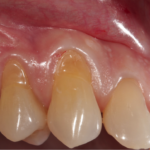
The coronally advanced flap (CAF) has been a common approach for the treatment of gingival recession for almost a hundred years. In recent years the use of a connective tissue graft (CTG) with CAF has been recommended as the best approach. However, the use of CTG increases morbidity for patients so a range of alternatives have been tested.
The aim of this review was to evaluate the long-term (≥2 years) stability of root coverage procedures for single gingival recessions.
Methods
Searches were conducted in the Cochrane Central Registry of Controlled trials (CENTRAL), Embase, Medline and the OpenGray databases. This was supplemented by hand searches of the journals, Journal of Clinical Periodontology, Journal of Periodontology, Journal of Periodontal Research and International Journal of Periodontics and Restorative Dentistry. Randomized controlled trials (RCTs) involving any type of treatment for gingival recessions with a follow‐up duration of at least 2 years were included.
Two reviewers independently selected studies extracted data and assessed risk of bias by considering random sequence generation, allocation concealment, blinding of participants and personnel, blinding of outcome assessment, incomplete outcome data, selective reporting and other bias. Risk ratio (RR) and mean difference (MD) with 95% confidence intervals (CIs) were used for the analysis of dichotomous data and continuous data. The primary outcomes were complete root coverage (CRC) and mean root coverage (MRC) with width of keratinized tissue (KTW) and patient-centred parameters as secondary outcomes. Meta-analysis was conducted when possible.
Results
- 15 RCTs (12 split mouth; 3 parallel design) were included.
- A total of 318 patients and 604 gingival recessions were initially enrolled.
- All studies included Miller Class I or/and II or dehiscence‐type gingival recessions.
- 11 studies were conducted in universities 4 in private practice.
- 2 studies were considered to be at low risk of bias, 1 at high risk and 12 at moderate risk.
- Meta‐analysis to compare the short‐term and long‐term outcomes after CAF procedure for single gingival recessions
| No. of studies | Relative Risk (95%CI) | Mean Difference (95%CI) | |
| Complete root coverage | 8 | 1.21 (0.99 – 1.48) | ——– |
| Mean root coverage | 4 | ——– | 7.29 (2.14 -12.44) |
| Keratinized tissue width | 8 | ——– | -0.12 (-0.28 – 0.05) |
- Meta‐analysis to compare the short‐term and long‐term outcomes after CAF + CTG procedure for single gingival recessions
| No. of studies | Relative Risk (95%CI) | Mean Difference (95%CI) | |
| Complete root coverage | 9 | 1.00 (0.90 – 1.10) | ——– |
| Mean root coverage | 4 | ——– | 2.35 (-0.36 -5.06) |
| Keratinized tissue width | 8 | ——– | -0.26 (-0.80 – 0.27) |
- Meta-analysis comparing CAF + CTG and CAF alone included 3 studies.
| No. of studies | Relative Risk (95%CI) | Mean Difference (95%CI) | |
| Complete root coverage short term | 3 | 0.80 (0.68 – 0.94) | ——– |
| Complete root coverage long term | 3 | 0.69 (0.56 – 0.46) | ——– |
| Keratinized tissue width short term | 3 | ——– | -0.26 (-0.80 – 0.27) |
| Keratinized tissue width long term | 3 | ——– | -0.63 (-1.21 to -0.04) |
- A few studies used alternative biomaterials of CTG, but no meta‐analysis was possible
- Only 5 out of 15 studies assessed hypersensitivity with all 5 reporting relief.
- 7 studies assessed aesthetics using different mainly qualitative approaches.
Conclusions
The authors concluded: –
within the limitations of the available results, this systematic review and meta‐analysis revealed that CAF alone may lose stability with time as the gingival margin had a tendency to shift apically. CAF + CTG could maintain long‐term stability and result in better long‐term efficacy of root coverage than CAF alone. The additional use of EMD may enhance the stability of CAF. However, insufficient evidence was available to evaluate the effectiveness of alternative biomaterials and the benefit of other root surface modifiers for long‐term stability. It should be encouraged to follow up patients continuously and report the long‐term results of both clinical and patient‐centred outcomes.
Comments
The 2018 Cochrane review by Chambrone et al looked at treatments for single and multiple recession-type defects including 48 studies. They showed that most root coverage procedures led to reduction in gingival recession. However, the certainty of the evidence was low to very low because of the quality of the evidence. The Cochrane review reported on outcomes between 6-12 months. The current review looks at outcomes at 2 years or more including 15 studies 8 of which were included in the Cochrane review and 4 being excluded as they did not meet Cochrane’s criteria. While the findings of the review suggest that a loss of stability with CAF alone and potentially more stable outcomes with CAF+CTG only two of the included studies were considered to be at low risk of bias so the findings should be viewed cautiously and further high quality well conducted and reported RCTs are needed.
Links
Primary Paper
Dai A, Huang JP, Ding PH, Chen LL. Long-term stability of root coverage procedures for single gingival recessions: A systematic review and meta-analysis.J Clin Periodontol. 2019 May;46(5):572-585. doi:10.1111/jcpe.13106. Epub 2019 Apr 29. Review. PubMed PMID: 30980404.
Other references
Dental Elf – 15th Oct 2018
Picture Credits
By Funkynatsuki [CC BY-SA 4.0], from Wikimedia Commons
